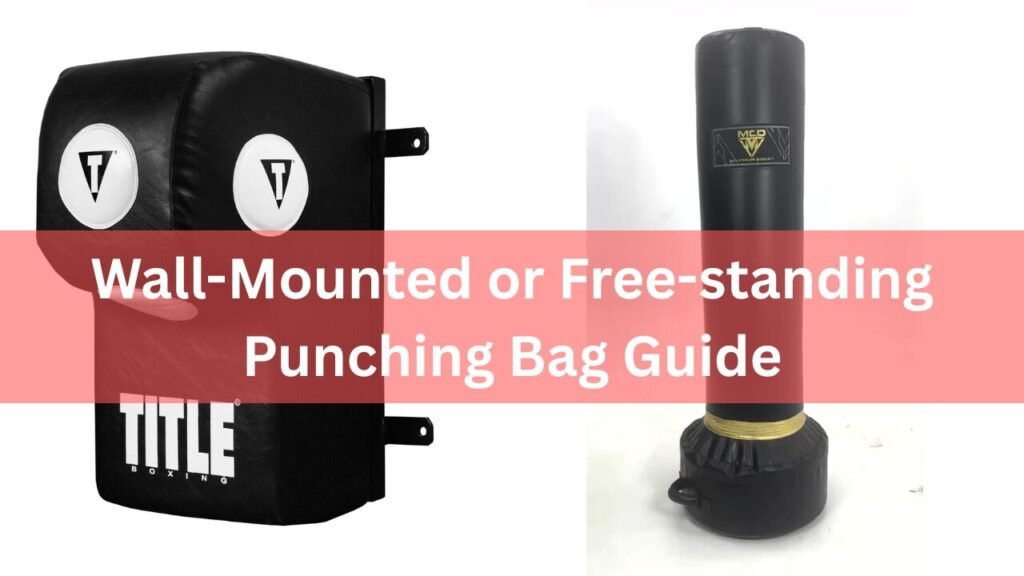Choosing the right punching bag is a crucial decision for boxers, martial artists, and fitness enthusiasts. The debate of wall-mounted vs free-standing punching bags has become more relevant than ever with modern training needs and space constraints. Whether you are a home gym owner or setting up a professional space, understanding the pros and cons of each can significantly impact your performance and convenience.
In this article, we’ll dive deep into the features, advantages, limitations, and best use cases for both options. By the end, you’ll have an informed perspective to decide which type of punching bag suits your training goals, budget, and available space.
Before comparing the two, it’s essential to understand what each punching bag type offers and why athletes, fitness trainers, and martial artists choose one over the other. Punching bags are more than just equipment; they influence skill development, endurance building, and overall fight performance.
What is a Wall-Mounted Punching Bag?
A wall-mounted punching bag is fixed directly onto a wall using heavy-duty brackets or frames. It can be a speed bag, uppercut bag, or heavy bag designed for powerful strikes.
Wall-mounted bags are commonly used in professional boxing gyms, MMA training centers, and dedicated home gyms. Their design is intended to stay in place, offering consistent resistance with every punch or strike. This makes them ideal for athletes who want stability and precision.
One of the reasons professionals trust wall-mounted bags is because they allow isolated, repetitive drills that help sharpen technique. A boxer can practice hundreds of straight punches, hooks, or uppercuts without worrying about bag movement. Over time, this improves punching accuracy, core strength, and wrist stability.
Wall-mounted setups are also compact, which means they save valuable floor space while offering a professional-grade training experience.
What is a Free-Standing Punching Bag?
Unlike wall-mounted bags, free-standing punching bags are not attached to any wall or ceiling. They stand independently on a weighted base, which is often filled with sand or water for stability.
Free-standing punching bags are widely used in fitness studios, martial arts schools, and home gyms. They are portable, convenient, and suitable for a wide range of workouts. Many newer models come with added features like shock absorbers, adjustable heights, and rebound resistance to mimic real opponents.
These bags are especially popular among beginners and recreational fitness users because they require no installation. A person can simply unpack the bag, fill the base, and start training. Their mobility also allows for varied training environments, from living rooms to garages and even outdoor patios during good weather.
Wall-Mounted vs Free-Standing Punching Bag: Side-by-Side Comparison
Installation and Space Requirements
Wall-mounted punching bags require permanent installation, meaning you’ll need sturdy walls and the ability to drill. They are best suited for garages, basements, or commercial gyms. The biggest advantage is that they save floor space, leaving room for other equipment. However, this makes them less ideal for apartments or shared housing.
Free-standing bags, on the other hand, require no installation. You can place them anywhere and reposition them when needed. This makes them a flexible choice for renters or people who want a non-permanent solution. The trade-off is that they occupy more floor space compared to wall-mounted versions. Free-standing bags win in terms of flexibility, but wall-mounted bags are better for compact gym setups.
Stability and Performance
Wall-mounted bags excel in stability. Once installed properly, they remain rock-solid and do not shift during training. This makes them the superior choice for athletes who want to focus on power punches and heavy strikes.
Free-standing bags, in comparison, can wobble or shift if the base isn’t filled properly. While this can be a disadvantage for pure power training, the slight movement can actually benefit cardio-focused routines, as it forces the athlete to adjust footwork and maintain balance. Wall-mounted bags are unmatched for power and consistency, while free-standing bags add a dynamic element to workouts.
Versatility and Training Style
Wall-mounted punching bags are excellent for precision-based drills but limited in versatility. Since they are fixed, they are not designed for full-body training that includes kicks, knee strikes, or footwork around the bag.
Free-standing punching bags allow 360-degree movement, making them highly versatile. Kickboxers, MMA fighters, and fitness enthusiasts benefit from the ability to strike from multiple angles. They can simulate real fight scenarios, which is useful for both sparring practice and conditioning. Free-standing punching bags offer more versatility for full-body workouts.
Durability and Maintenance
Wall-mounted punching bags are highly durable when installed correctly. Since they remain fixed, they require minimal maintenance. The bag itself may need occasional replacement after years of heavy use, but the frame or bracket can last for decades.
Free-standing punching bags, however, require more maintenance. The bases can crack over time, the springs may loosen, and water-filled bases may need frequent checks for leaks. Sand-filled bases are heavier and more reliable, but they still require periodic adjustments. Wall-mounted bags win when it comes to long-term durability.
Cost and Value for Money
Wall-mounted punching bags are generally more affordable upfront, but installation can add to the overall cost. They are an excellent value for serious athletes who have a permanent training space.
Free-standing bags are typically more expensive, especially premium models with shock absorption or adjustable features. However, they eliminate installation costs and offer greater flexibility. For families or group users, the investment is often worth it. Cost depends on your goals wall-mounted for serious trainees, free-standing for shared or flexible use.
Real-World Examples
To better understand, let’s look at real-world situations.
John, a fitness enthusiast living in a rented apartment, wanted a punching bag for stress relief and fitness. Since drilling into walls wasn’t allowed, he chose a free-standing bag. Over time, he adapted his workouts to include both cardio drills and power training, appreciating the flexibility of moving the bag between his living room and balcony.
Maria, a professional boxer, built a dedicated garage gym with a wall-mounted heavy bag. She uses it to practice power strikes, hooks, and uppercuts. The fixed resistance helps her develop knockout strength and sharpen her punching accuracy.
These examples show how lifestyle, environment, and training goals directly affect the right choice.
Expert Recommendations
Fitness trainers often recommend free-standing bags for beginners or renters, especially models like the Everlast PowerCore, which balance portability with stability. Professional fighters and power punchers, on the other hand, benefit more from wall-mounted bags like those from RDX Sports, which provide resistance for advanced drills.
Some experts even suggest combining both if possible. Using a free-standing bag for movement and cardio drills while relying on a wall-mounted bag for power strikes can provide a complete training routine.
Noise and Disruption
Wall-mounted bags can cause vibrations and noise, especially if attached to thin walls. This may disturb neighbors in apartment settings. Free-standing bags are generally quieter, though striking them on hard floors can still generate sound.
Safety and Injury Risk
Wall-mounted bags, due to their stability, can increase strain on wrists and knuckles if punches are poorly executed. Free-standing bags provide some give, reducing joint stress but posing a risk if the base shifts unexpectedly during training.
Customization Options
Free-standing models often come with adjustable heights, target zones, and reflex attachments, making them highly adaptable. Wall-mounted setups are less flexible but can still be enhanced by adding nearby double-end or speed bags.
FAQs
What is the best punching bag for small apartments?
Free-standing bags are ideal as they don’t require drilling and can be stored easily. Some models also include wheels for better mobility.
Can you kick a wall-mounted punching bag?
Typically, no. Wall-mounted bags are not designed for kicks due to their fixed position. Kicks may damage both the bag and the wall.
Are wall-mounted punching bags suitable for beginners?
Not always. They require more power and technique. Beginners may prefer the flexibility of free-standing options to explore different angles and techniques safely.
How do I stabilize a free-standing punching bag?
Fill the base with sand (heavier than water) and place it on a non-slip mat. Some users also add foam pads around the base for added safety.
Which punching bag lasts longer?
Wall-mounted bags tend to last longer due to their fixed structure and fewer moving parts. However, free-standing bags with durable materials and proper care can also last for years.
Conclusion
The choice between a wall-mounted vs free-standing punching bag ultimately comes down to your goals, space, and training style.
If you need portability, flexibility, and beginner-friendly training, a free-standing bag is the ideal choice. If you want durability, resistance, and advanced power training, a wall-mounted bag is the better investment.
For the best of both worlds, some athletes even integrate both into their training, using each for different aspects of development. Whichever you choose, align your decision with your fitness objectives and environment. And if you’re still unsure, explore our expert reviews and training guides on Boxing Essential to find the perfect fit for your needs.




